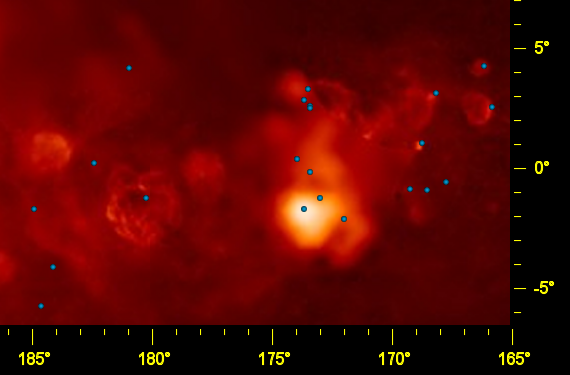
Hover your mouse over each blue dot for the name of the object, or click on the dot for a detail page. This map was created using the all-sky hydrogen-alpha map produced by Douglas Finkbeiner from data collected by the WHAM, VTSS and SHASSA hydrogen-alpha surveys.
The brightest nebula on this hydrogen-alpha image is the Tadpole nebula (NGC 1893, Sh 2-236) at 3200 parsecs, which lies at the core of the Auriga OB2 association. This region is very confusing, however. In front of it is the Auriga OB1 association, with many bright stars but no major HII regions, at a distance of about 1300 parsecs. Auriga OB1 is usually considered to belong to the Orion arc. On the other hand, the Diaz et. al. cluster database has the distance to the NGC 1893 cluster as 6000 parsecs, suggesting that many and perhaps most of the stars in Auriga OB2 are twice as far away as formerly believed. Appearing to surround the Auriga OB2 association is the huge diffuse nebula Sh 2-230. Clearly more research is needed to work out the distances of the stars and nebulae in this direction. More details on the complex situation can be found in the Auriga section of this recent paper.
Far in front of Sh 2-230 is the Flaming Star nebula (Sh 2-229), at 510 parsecs. The Flaming Star nebula surrounds the runaway O9.5Ve star AE Aurigae, which is believed to have been knocked out of Orion's Trapezium cluster by an interstellar collision about 2.5 million years ago.
At distances in between the Flaming Star and Tadpole nebulae are the Spider and Fly nebulae. The Spider nebula (IC 417, Sh 2-234) is located at 2300 parsecs and may be associated with the star cluster Stock 8, which appears in the same field. The Fly nebula (Sh 2-237) appears to be slightly closer at 1800 parsecs and surrounds the ten-million-year-old star cluster NGC 1931.
North of the Tadpole nebula is the huge molecular cloud complex at 1800 parsecs associated with the nebulae Sh 2-231, the peculiar belted Sh 2-232, Sh 2-233, and the kidney-shaped Sh 2-235. At least one paper suggests that the Fly nebula (Sh 2-237) may also be related to this complex as it is at a similar distance. The two largest colliding molecular clouds in this region consist of 100 thousand and 300 thousand solar masses of gas and dust respectively and are causing intense star formation near and within Sh 2-235.
To the right of this region on the image are the mysterious nebulae Sh 2-225 at 3700 parsecs and Sh 2-227 at 4300 parsecs. Essentially nothing appears in the scientific literature on these objects despite the obvious and distinct nebulosity in this region. The two obvious bubbles on the far right of the image are both supernova remnants - SNR G166.1 +4.4 (Sh 2-224) at 4500 parsecs and SNR 166.2+02.5 (Sh 2-223) at 8000 parsecs.
Just below the galactic plane on the right of the image are three small nebulae. BFS 45 at 4100 parsecs is nearby Sh 2-226 at 4200 parsecs, while Sh 2-228 is much further away at 8000 parsecs.
The large bubble on the left side of the image is the supernova remnant SNR 180.0-01.7 (Sim 147, Sh 2-240), which lies at a distance of only 800 parsecs. (Sim 147 is often, but incorrectly, shortened to S147.) Just to the upper left of Sim 147 is Sh 2-242 at 2700 parsecs. Sh 2-241 at 5300 parsecs appears to lie in the middle of a large region of faint emission to the north. The bubble to the upper right of Sim 147 is in the vicinity of LBN 818, which SIMBAD identifies as a relection nebula.
The nebula at the bottom left of the image is the Crab nebula (M1, Sh 2-244), perhaps the most famous supernova remnant in the sky. The Crab nebula is the remnant of a supernova which exploded in the year 1054.
The other two nebulae on the left of the image are the tiny BFS 50 and Sh 2-243, which does not appear to be visible at radio or visible light frequencies and may not exist.
The obvious bubble on the far left of the image and just above the galactic plane is near the nebula BFS 49, which is not currently in the Galaxy Map database (but soon should be).
